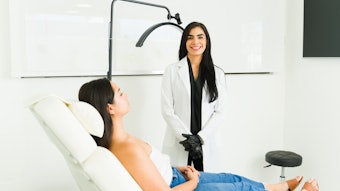Editor's note: As a spa professional, you are in a unique position to be able to help clients identify skin cancer. Be sure to make note of any marks that appear odd, according to the information below, and be sure to recommend a visit to the dermatologist if it is in order. Also, it is important to be able to refer clients to a reputable dermatologist if they don't already have one. One more thing ... make sure that clients perform the home skin care checks as advised in this piece.
Skin cancer is a scary subject. "No one wants to think about developing a disfiguring, even deadly, disease, therefore so many Americans live in a state of denial," says Joshua Fox, MD, a leading dermatologist and medical director of Advanced Dermatology of New York and New Jersey. "Most people know they are supposed to be checking their skin monthly for changes that might be cancer, but they aren't exactly diligent about it. It's something that gets put off for later, often indefinitely."
But skipping the skin scans can be dangerous, says Paige Farkas, MD, a dermatologist specializing in skin cancer screening at Advanced Dermatology. "There have been significant advances in the treatment of skin cancer, including the deadly types, but we know that the front-end things--detection, diagnosis and immediate treatment--are still critical." In fact, she says, despite the fact that skin cancer is among the simplest types of cancer to identify since it's visible on the outside of the body, the rates continue to rise. And although nonmelanoma cancers have a relatively good prognosis, melanoma, the deadliest form of skin cancer, can quickly become lethal. In fact, new research shows that melanoma cells have a unique ability to override even the healthiest immune system, eventually spreading far beyond the initial site.
The truth is, checking your skin regularly, and making an appointment to have your dermatologist do the same, is the best and only way to catch skin cancer before it spreads. "For the past 25 years, we've told people to pay attention to the ABCDs of pigmented skin irregularities," Fox says. "Asymmetry, border irregularity, color variation, and diameter more than 6 mm (about ¼ inch). These are still the key to identifying a problem growth among a bunch of innocuous looking freckles and moles," he says.
Here are the rules of skin cancer screening. Make sure your clients do these at home.
Make it a habit to check skin at home.
Fox recommends checking yourself, head to toe, once a month. That means stripping down to your birthday suit and looking over every inch of skin, even in areas where you'll need a hand mirror to get a good look. "Many cases of melanoma and other cancers develop on the scalp," Fox says. "These cancers can be deadly, but unfortunately, most people don't check the tops of their heads very often." Be sure to check the palms of your hands, your nails, and the soles of your feet, too.
Know what is normal.
In most cases, a normal mole is an even brown, tan or black color, which can be either flat or raised, round or oval. Some moles are present at birth, others develop during childhood or even later in life, especially in areas that get lots of sun. Once a mole is there, it will most likely stay the same size, shape and color. Some moles eventually fade and disappear. "Almost everybody has moles, and almost all of those moles are harmless," Fox says. But people with lots of moles, more than 50, are at a higher risk for skin cancer.
What's not normal: Flesh-colored, pearl-like bumps or pinkish or reddish patches of skin that flake or scale (or even bleed), which can be basal cell or squamous cell carcinomas.
Pay attention to changes in your skin.
Look for anything new, a new mark, or an old mark that looks different, as well as any new sensations in or around a freckle or mole. In some cases, the skin can become crusty or scaly, or start to feel itchy or even sore. Pay attention to any marks that change in color, size or shape, as well as marks that just look different from the other marks on your body. "Spots on the skin come in all shapes and sizes, and not every mark you see will be cancer," Fox says. "But if you see something that really stands out, what dermatologists call an 'ugly duckling', be sure to tell your dermatologist in a timely manner."
Schedule an annual skin check with your dermatologist.
Most people should see the dermatologist once a year--and anyone who's had skin cancer already or who has other significant risk factors should make it at least every six months. At this exam, the doctor will check your skin and discuss any changes that the two of you have found.
Find a dermatologist who uses dermatoscopy technology.
Also known as epiluminescence microscopy [ELM], or surface microscopy, this is a relatively new (and not-too-common) method of screening that's extremely effective at identifying cancers, helping the doctor distinguish malignant lesions from benign ones, says Farkas, who uses a dermatoscope in her practice at Advanced Dermatology. "The dermatoscope uses polarized light and a magnifying lens to let us 'see' the skin more clearly," she explains. "It significantly increases the accuracy of the exam, meaning we can detect problems much more reliably than with the naked eye."










